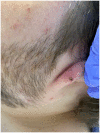Case report: Hospital-acquired chickenpox in a healthcare setting
- PMID: 38112097
- PMCID: PMC10804131
- DOI: 10.1017/S0950268823001917
Case report: Hospital-acquired chickenpox in a healthcare setting
Abstract
Chickenpox (varicella) is a rare occurrence in healthcare settings in the USA, but can be transmitted to healthcare workers (HCWs) from patients with herpes zoster who, in turn, can potentially transmit it further to unimmunized, immunosuppressed, at-risk, vulnerable patients. It is uncommon due to the inclusion of varicella vaccination in the recommended immunization schedule for children and screening for varicella immunity in HCWs during employment. We present a case report of hospital-acquired chickenpox in a patient who developed the infection during his prolonged hospital stay through a HCW who had contracted chickenpox after exposure to our patient's roommate with herpes zoster. There was no physical contact between the roommates, but both patients had a common HCW as caregiver. The herpes zoster patient was placed in airborne precautions immediately, but the HCW continued to work and have physical contact with our patient. The HCW initially developed chickenpox 18 days after exposure to the patient with herpes zoster, and our patient developed chickenpox 17 days after the HCW. The timeline and two incubation periods, prior to our patient developing chickenpox, indicate transmission of chickenpox in the HCW from exposure to the herpes zoster patient and subsequently to our patient. The case highlights the potential for nosocomial transmission of chickenpox (varicella) to unimmunized HCWs from exposure to patients with herpes zoster and further transmission to unimmunized patients. Verification of the immunization status of HCWs at the time of employment, mandating immunity, furloughing unimmunized staff after exposure to herpes zoster, and postexposure prophylaxis with vaccination or varicella zoster immunoglobulin (Varizig) will minimize the risk of transmission of communicable diseases like chickenpox in healthcare settings. Additionally, establishing patients' immunity, heightened vigilance and early identification of herpes zoster in hospitalized patients, and initiation of appropriate infection control immediately will further prevent such occurrences and improve patient safety.
This is a case report of a varicella-unimmunized 31-year-old patient who developed chickenpox during his 80-day-long hospitalization. He had different roommates during his long hospital stay but had no physical contact with them and neither had visitors. On most days, the same HCW rendered care to him and his roommates. One of the patient’s roommates was found to have herpes zoster and was immediately moved to a different room with appropriate infection prevention measures. The HCW is presumably unimmunized to varicella and sustained significant exposure to the patient with herpes zoster during routine patient care which involved significant physical contact. The HCW was not furloughed, assessed for immunity, or given postexposure prophylaxis (PEP). The HCW had continued contact with our patient as part of routine care. On day 18, after exposure to the patient with herpes zoster, the HCW developed chickenpox. 17 days thereafter, our patient developed chickenpox. The time interval of chickenpox infection in the HCW after one incubation period after exposure to the patient with herpes zoster followed by a similar infection of chickenpox in our patient after another incubation period suggests the spread of varicella zoster virus (VZV) from the herpes zoster patient to the HCW and further from the HCW to our patient. Assessing the immunity of HCWs to varicella at the time of employment, ensuring only HCWs with immunity take care of herpes zoster and varicella patients, furloughing unimmunized exposed HCWs, offering PEP, and documentation of patients’ immunity to varicella at the time of hospital admission could help prevent VZV transmission in hospital settings. This is an attempt to publish this novel case due to its high educational value and relevant learning points.
Keywords: chickenpox; epidemiology; herpes zoster; infection prevention; nosocomial transmission; shingles; varicella; varicella zoster virus (VZV).
Figures






Similar articles
-
Varicella zoster virus immunity in multinational health care workers of a Saudi Arabian hospital.Am J Infect Control. 2003 Oct;31(6):375-81. doi: 10.1016/s0196-6553(02)48204-1. Am J Infect Control. 2003. PMID: 14608306
-
Outbreak of varicella-zoster virus infection among Thai healthcare workers.Infect Control Hosp Epidemiol. 2007 Apr;28(4):430-4. doi: 10.1086/512639. Epub 2007 Feb 26. Infect Control Hosp Epidemiol. 2007. PMID: 17385149
-
Implementation of Hospital Policy for Healthcare Workers and Patients Exposed to Varicella-Zoster Virus.J Korean Med Sci. 2018 Aug 27;33(36):e252. doi: 10.3346/jkms.2018.33.e252. eCollection 2018 Sep 3. J Korean Med Sci. 2018. PMID: 30181734 Free PMC article. Review.
-
Nosocomial transmission of chickenpox and varicella zoster virus seroprevalence rate amongst healthcare workers in a teaching hospital in China.BMC Infect Dis. 2019 Jul 5;19(1):582. doi: 10.1186/s12879-019-4222-x. BMC Infect Dis. 2019. PMID: 31277589 Free PMC article.
-
Effect of Routine Varicella Immunization on the Epidemiology and Immunogenicity of Varicella and Shingles.Viruses. 2022 Mar 12;14(3):588. doi: 10.3390/v14030588. Viruses. 2022. PMID: 35336994 Free PMC article. Review.
Cited by
-
Varicella zoster virus outbreak in a long-term care unit of a tertiary care hospital in northern India.Epidemiol Infect. 2024 May 13;152:e81. doi: 10.1017/S0950268824000712. Epidemiol Infect. 2024. PMID: 38736415 Free PMC article.
-
Epidemiologic Investigation of a Varicella Outbreak in an Elementary School in Gyeonggi Province, Republic of Korea.Children (Basel). 2025 Jul 18;12(7):949. doi: 10.3390/children12070949. Children (Basel). 2025. PMID: 40723142 Free PMC article.
References
-
- Ayoade F and Kumar S (2023) Varicella-Zoster Virus (Chickenpox) (Updated 2022 Oct 15). StatPearls (Internet). Treasure Island (FL): StatPearls Publishing; 2023 January. Available from: https://www.ncbi.nlm.nih.gov/books/NBK448191/. - PubMed
-
- InformedHealth.org (Internet) (2014). Cologne, Germany: Institute for Quality and Efficiency in Health Care (IQWiG); 2006. Chickenpox: Overview. 2014 June 30 (Updated 2019 November 21). Available from: https://www.ncbi.nlm.nih.gov/books/NBK279621/.
-
- Centers for Disease Control and Prevention. (2014, November 19). State Immunization Laws for Healthcare Workers and Patients. Centers for Disease Control and Prevention. Available at https://www2a.cdc.gov/vaccines/statevaccsApp/Administration.asp?statetmp....
Publication types
MeSH terms
Substances
LinkOut - more resources
Full Text Sources
Medical
Miscellaneous

